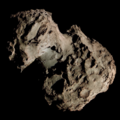 Comet 259/P Garradd in two different dates, one that was active (left) and one in which it appears inactive (right) | |
| Discovery [1] | |
|---|---|
| Discovered by | Gordon J. Garradd |
| Discovery date | September 2, 2008 |
| Designations | |
| P/2008 R1 | |
| Orbital characteristics [2] | |
| Epoch | 26 February 2011 |
| Aphelion | 3.659 AU |
| Perihelion | 1.796 AU |
| Semi-major axis | 2.727 AU |
| Eccentricity | 0.3415 |
| Orbital period | 4.50 years |
| Inclination | 15.899° |
| Last perihelion | 8 February 2022 |
| Next perihelion | 11 August 2026 |
| TJupiter | 3.217 |
| Earth MOID | 0.858 AU |
| Comet total magnitude (M1) | 13.7 |
259P/Garradd is a Jupiter-family comet and active asteroid with an orbital period of 4.5 years. It was discovered in images obtained on 2 September 2008 as part of the Siding Spring Survey by Gordon J. Garradd. [1] [3]
The comet upon discovery had an apparent magnitude of 18.5 and a coma about 15 arcseconds across. [1] The comet dimmed by 1.5 magnitudes until mid November 2008. The spectrum of the comet during that period indicated a lack of gaseous emission lines and the mass loss rate was estimated to be less than 1.5 kg/s. [4] The comet was observed in 2011-12, when it was inactive, with the observations indicating an effective radius of about 0.3 kilometers assuming a geometric albedo of 0.05. [5] [6]
The comet was observed to be active again during the 2017 perihelion, indicating that the source of activity is sublimation. The activity started to be detected when the comet was about 2 AU from the Sun, indicating that volatile ices are located deeper under the surface, as they have been probably more depleted due to the fact that it approaches closer to the Sun during perihelion than other active asteroids. [7]
The orbit of the comet is unstable within a timescale of tens of millions years. It lies near the 3:8 orbital resonanse with Jupiter. It has a Jupiter Tisserand parameter of over three, indicating that it originates from the main asteroid belt instead of the Kuiper belt. [4] It does not belong to a known asteroid family. [8]

